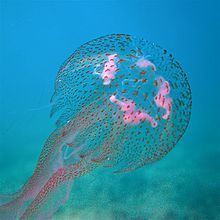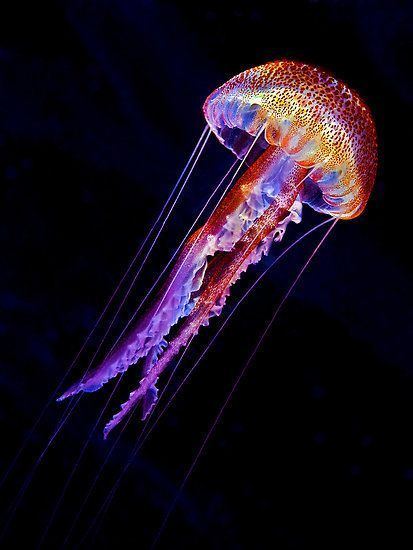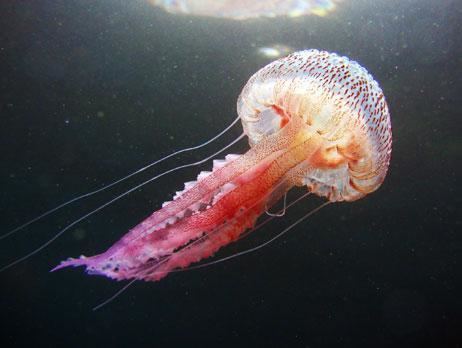Genus Pelagia Rank Species | Scientific name Pelagia noctiluca Higher classification Pelagia | |
 | ||
Similar Pelagia, Cnidaria, Rhizostoma pulmo, Scyphozoa, Rhizostoma | ||
Pelagia noctiluca (Forsskal, 1775) is a jellyfish in the family Pelagiidae. In Latin, pelagia means "of the sea", nocti stands for night and luca means light; thus, Pelagia noctiluca can be described as a marine organism with the ability to glow in the dark.
Contents

This species of jellyfish, known in Europe as the mauve stinger amongst many other common names, is widely distributed in all warm and temperate waters of the world's oceans, including the Mediterranean Sea, Red Sea and Atlantic Ocean. It is also found in the Pacific Ocean, with sightings in warm waters off Hawaii, southern California and Mexico, as well as other Pacific locations. This is typically an offshore species, although sometimes it is washed near the coastlines and may be stranded in great numbers on beaches. The color varies worldwide, and in addition to pink or mauve, it is sometimes shades of golden yellow to tan.

In an unprecedented event on November 21, 2007, a 10-square-mile (26 km2) swarm of P. noctiluca wiped out a 100,000-fish salmon farm in Northern Ireland, causing around £1 million worth of damage.

Description

The body is radially symmetrical. There is only one body cavity known as the gastrovascular cavity. This is a primitive gut or digestive cavity with only one opening that is used for ingestion and excretion; there are four long oral arms with crenulated margins that are the primary feeding surface. Each P. noctiluca medusa has 8 long tentacles that emerge from the umbrella margin. Being radially symmetrical it has no head and thus no centralized nervous system. The nervous system present is primitive, consisting of a simple net composed of naked and largely non-polar neurons. In addition P. noctiluca also lacks a gaseous exchange, excretory and circulatory system. However cnidaria have evolved cnidae, cells which serve for a variety of functions that include prey capture, defense, locomotion and attachment. When fully formed cnidae are called cnidocytes. When stimulated the cnidae secrete nematocyst toxins that are biological poisons.
Life cycle and reproduction

P. noctiluca is a member of the cnidarian class Scyphozoa and adapted to a pelagic mode of life. Whereas most scyphozoan jellyfish (also called scyphomedusae) have a complex life cycle with both the pelagic (swimming) jellyfish, or medusa, stage and a bottom-living polyp stage, Pelagia has adapted in such a way that the polyp stage is absent, thus direct development exists. The male and female jellyfish spawn respectively sperm and eggs, which develop directly into young (male or female) Pelagia noctiluca jellyfish. These organisms have a well-developed manubrium, a proboscis-like structure bearing the mouth and four long oral arms. Also the mesoglea, or jelly, is relatively thickened and well developed in this species. Sense organs, known as rhopalia in the scyphomedusae, are located around the umbrella margin in notches and alternate between tentacles. Cnidae are present in the epidermis and gastrodermis of the umbrella, as well as on the tentacles.
P. noctiluca has eight marginal tentacles alternating with eight marginal sense organs. This species reproduces sexually. Four gonads arise as elongated endodermal proliferations, developing into ribbon-like folds in the interradial sectors of the stomach wall slightly distal to the rows of gastric filaments. Male and female gonads vary only slightly and the main difference is the thickness of the follicle. Eggs are laid between 12pm and 2pm in December in Mediterranean specimens as described by Metschnikoff (1886). After 3 days the egg develops in a planula; at this stage movement is only done by ciliary action. After 7 days, planulae develop into ephyra which develop into young medusa after a month.
Reactions
Feeding reactions were studied by Bozler (1926), where a piece of food was given to the marginal tentacle, the tentacle contracted quickly. There was a slow contraction of the coronal muscle which brought the tentacle nearer to the mouth. The food was grasped by the lip of one of the oral arm and transported slowly along until it reached the stomach. They were found to feed on Thalia democratica; however, they are found mainly to feed by taking food particle by the amoeboid process of the endoderm cells, thus being suspension feeders.
Movement is caused when the medusa pulsates, as the marginal tentacles are contracted, straightened and stiffened. Pulsation was found to be optimal between 8° to 26 °C. Movement is only restricted vertically and thus P. noctiluca are carried in large swarms by currents.
P. noctiluca are bioluminescent, i.e. have an ability to produce light. Light is emitted in the form of flashes when the medusa is stimulated by turbulence created by waves or by a ship's motion. This flashing is only of relatively short duration and gradually fades.
